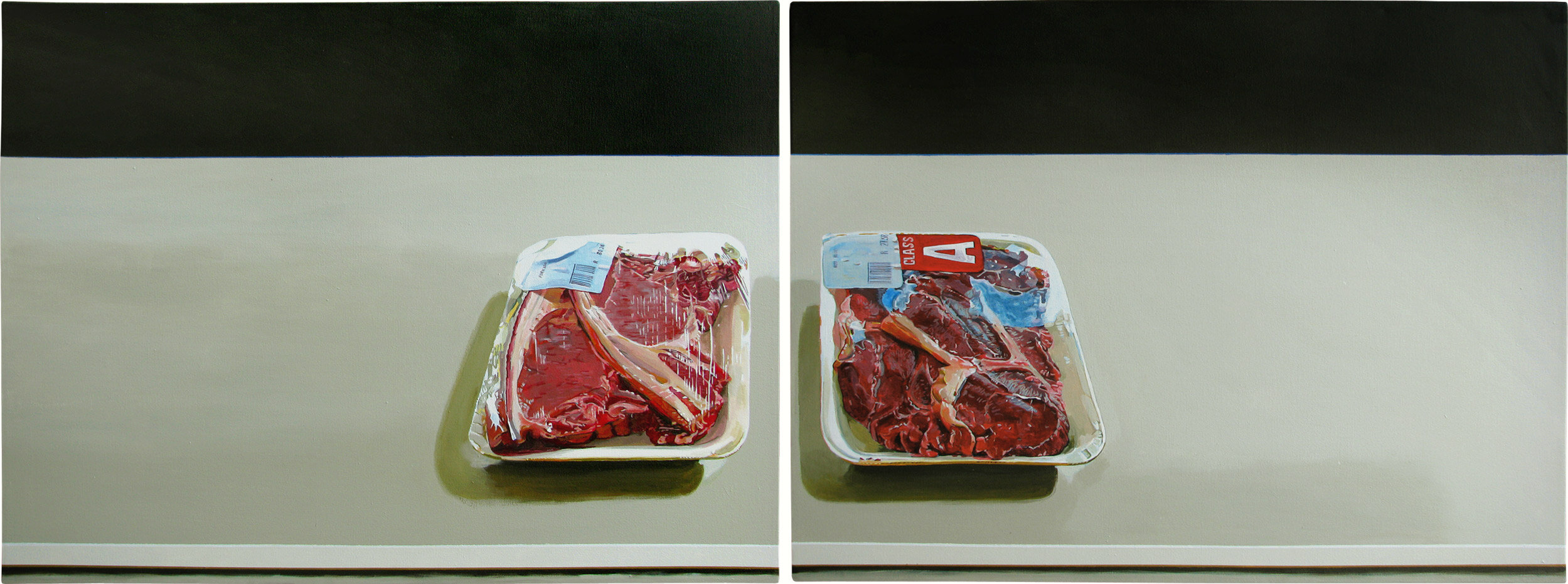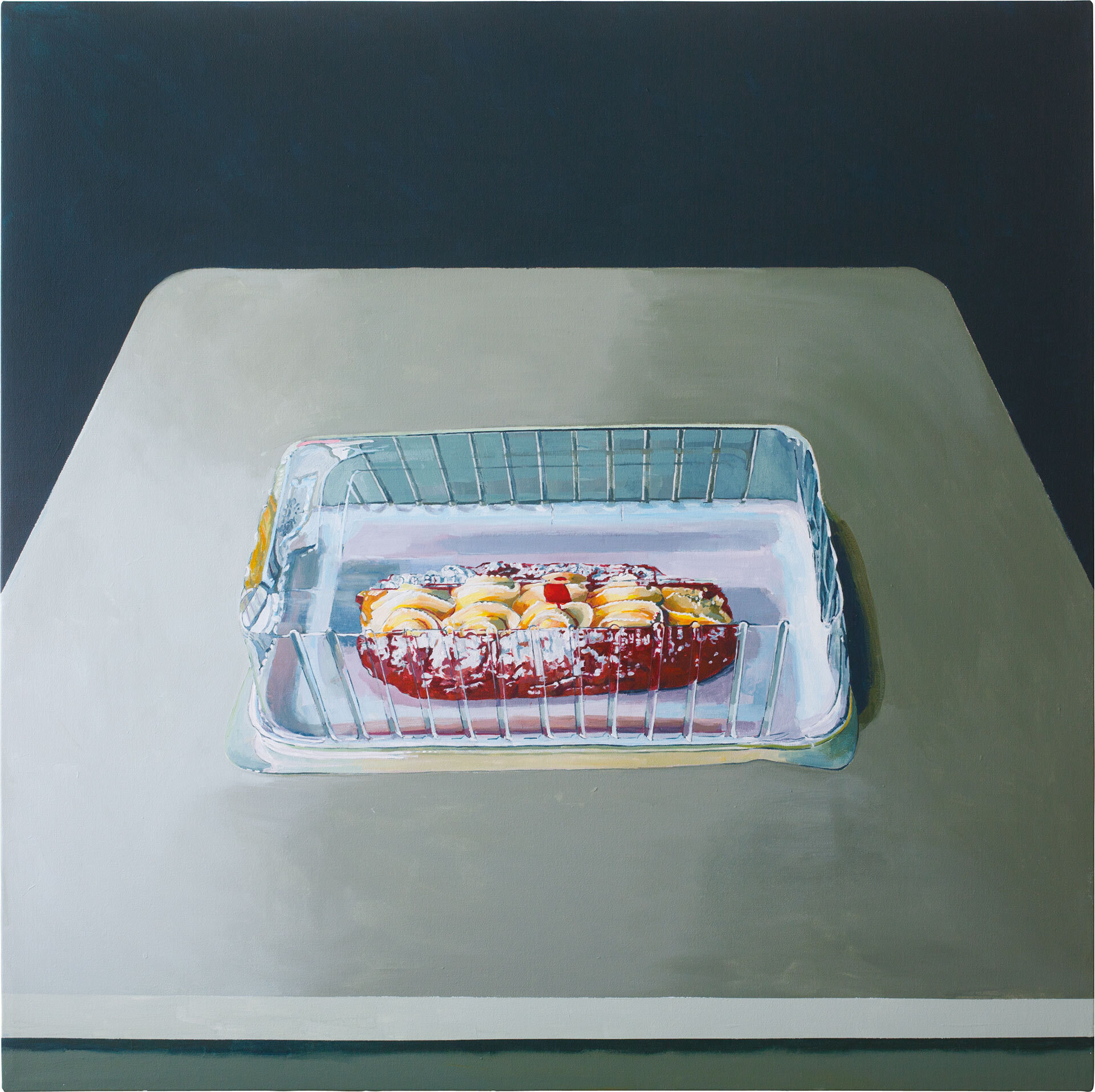In this latest body of work, completed between 2009 and 2018, the artist confronts the viewer with three investigations of the same theme: cuts of meat, baked goods and fresh produce, all rendered on an oversized, visceral scale.
While these representations of packaged consumer goods may certainly be interpreted as contemporary still life, their scale and candidness encourage the viewer to assess the works on a number of additional levels.
Throughout the series, Nel chooses to depict her subject matter in relation to a thin membrane of plastic wrap, a now-ubiquitous material that has been associated with the packaging of edible items since the mid-twentieth century. Represented as either intact (and therefore sterile) or breached (and thereby rendering its contents vulnerable to decay), this film becomes an interface between an outer and inner reality, and a means for Nel to explore how sexualisation, abjection and the abuse of power inform the female identity.
In her studies of baked goods, Nel uses processed confectionery – and the packaging that encases it – as a representation of the paradoxical power and vulnerability of female sexuality. Here, glazed frosting and piped cream immediately call to mind female genitalia or breasts, as in Cream Bun (2014) and Two Buns I (2014) respectively. The plastic wrap, while ostensibly serving to preserve its contents, in actuality offers minimal protection against eventual violation.
For Nel, this tension speaks to the notion of paradisus amissus, where innocence – particularly that of the girl child, is irrevocably lost. When considered from the perspective of recent revelations of sexual abuse and harassment within the American political and entertainment arenas, these works take on even greater topical significance. In the process of exploring baked goods as a metaphor for female sexual objectification, degradation and assault, Nel also began investigating how this theme might relate to the ageing female in particular. By documenting confectionery before and after the effects of decay set in, Nel not only touches on the modern preoccupation with artificially prolonging and enhancing female sexual desirability, but also the inevitable process of ageing and ultimate rejection of the aged female from society.
"Best Before I and II are the result of my investigations. Here, the baked goods are encased in plastic wrap, which serves only as a temporary shield against eventual decomposition. So too the body continues with the process of decay and death."
Similarly, Nel’s explorations of raw meat serve to extract complex and contradictory responses from the viewer. The most visceral and challenging of the series, the still-bloodied cuts speaks of an earlier, unseen emotional or physical brutality, while the plastic and styrofoam serves to sanitise, commodify and even ritualise this violence.
“Many of these works use meat as a metaphor – in particular the juxtaposition of flesh before and after its protective sheath has been torn open. Slab I and II suggest physical violence that has led to death, the “slab” alluding to the mortuary table and post-death examination. They negotiate the nature of domestic abuse, which is a private type of an assault yet one which occurs universally, irrespective of class, age, race and even gender.”
This neatness of presentation also infers the ritualisation and mythologisation of flesh, especially on the African continent, and in particular, of the female body. As with the works depicting baked goods, many of the meat paintings are titled in reference to terminology used to infantilise, sexualise, undermine or objectify women. The relationship between innocence and corruption is further demonstrated in Nel’s explorations of fresh produce, which perhaps represent the most subtle notes within the exhibition. Here too, bags of fruit are subjected to softening and eventual decomposition – often, within the very medium intended to prevent such processes. While works such as Bruised I may certainly be interpreted as contemporary renditions of Dutch vanitas paintings, they also powerfully express Nel’s concern with the covert nature of the abuse of power, whether sexual, emotional, physical or political.
Key Work
Bleed II, 2015.
Acrylic on canvas, 50 cm x 50 cm
An extension of Nel’s earlier explorations of meat, such as Best Buy (2009), Bleed II represents a more intimate – and visceral – examination of the same subject matter, by pairing oversized proportions with smaller canvas dimensions. The uncomfortable proximity of flesh is at once repulsive and compelling or, what poststructuralist philosopher Julia Kristeva describes as “a vortex of summons and repulsion”. Kristeva’s concept of abjection is, indeed, a useful framework to apply in reading Bleed II as well as similar work from this series. Presented in its raw state, exuding blood and bound by fat, the meat depicted here can easily be considered abject in the same manner as a corpse might be – that which “disturbs identity, system, order”, forcing the viewer to violently separate their self from the object that is considered intolerable. Simultaneously, however, modern socio-cultural conditioning around the production and consumption of meat has normalised and even ritualised this abject response. The inclusion of polystyrene and plastic packaging materials in Bleed II, as well as Nel’s other meat studies, are therefore vital elements in understanding the viewer’s complex and contradictory relationship with the subject matter.
Key Work
Best Before I, 2012.
Acrylic on canvas, 150 cm x 75 cm (diptych)
Initially completed as a single canvas, Best Before I was extended into a diptych when Nel rediscovered her reference material after inadvertently forgetting it in storage for several weeks. Despite its heavily synthetic constitution, plastic packaging and refrigerated storage conditions, the cream bun had finally begun to spoil, enveloped by mould. For Nel, this not only made for an intriguing textural study, but also presented an opportunity to explore the contrast between preservation and corruption.
This dialogue can be read on many levels, be it the process of physical ageing, mental deterioration or the loss of sexual appeal or social relevance in a Millennial culture centred on youth and self-care. Our attempts to mitigate the inevitable process of entropy are manifold, be it through cosmetic surgery, dietary supplements, physical conditioning or the representation of self through social media. As with Nel’s meat studies, this before-and-after can be read as a modern-day memento mori – a nod to Dutch Golden Age depictions of perishable fruit and sweetmeats in vanitas paintings such as Abraham Mignon’s Still Life with Fruit, Foliage and Insects (c. 1669) and Pieter Claesz’ Still Life with a Turkey Pie (1627).
Key Work
Two Buns I, 2014.
Acrylic on canvas, 75 cm x 75 cm
As a secondary line of investigation following her initial studies of meat, Nel went on to explore the representation of commercially-processed confectionery. In Two Buns I, we are confronted with a pair of larger-than-life sugar-glazed doughnuts, cleanly and individually contained in polystyrene and plastic wrap, and positioned side-by-side on a nearly two-dimensional surface. The pastries are simultaneously inviting and repulsive, their thick frosting intensely enticing yet somehow almost putrid in appearance. The form and presentation of the baked goods immediately call to mind the fetishisation of breasts – the packaging perhaps serving as a reference to contemporary social preoccupation with the artificial preservation and enhancement of the female form through cosmetic surgery. The plastic wrapping, while able to provisionally delay deterioration, will not prevent decay and eventual decomposition. Given the influence of Pop Art on Nel as a student and young professional artist, her confectionery pieces can be seen as a contemporary ode to Wayne Thiebaud’s display cakes and pie slices, only permeated with a sense of foreboding and unease, much like a modern-day vanitas painting.
Key Work
Wrapped I, 2009.
Acrylic on canvas, 100 cm x 100 cm
Wrapped I represents an important transition within Nel’s oeuvre, bridging her interest in figurative subject matter, which has informed the majority of her output, and her study of consumer goods, which has dominated the last decade of her career. The apple is a universal symbolic representation of entropy, mortality and the fall of man – a motif employed throughout Western art history, from Dürer’s 1504 engraving of Adam and Eve, to Eric Fischl’s Bad Boy (1981). So too in several works from Nel’s postmodern period, such as The Maids in Waiting (1991), Shrine (1997) and Waiting for the Renaissance (1998 - 1999), the apple serves to suggest the loss of sexual or socio-political innocence. In contrast to the dense composition of these earlier works, however, Wrapped I presents the fruit completely in isolation, at an oversized scale, and centred on a canvas with very limited planar depth – forcing the viewer to contemplate its presence, purpose and presentation to the exclusion of all else. The inclusion of plastic packaging holds the most significant departure from Nel’s earlier representations, introducing a dialogue between the natural and artificial, preservation and corruption, naïveté and maturity.





















